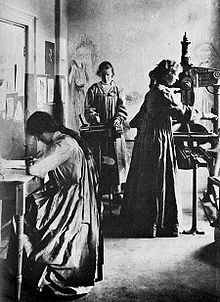Small press
This article needs additional citations for verification. (April 2019) |

A small press is a
Independent press is generally defined as publishers that are not part of large conglomerates or multinational corporations. Many small presses rely on specialization in genre fiction, poetry, or limited-edition books or magazines, but there are also thousands that focus on niche non-fiction markets.
Definitions
In the United States, a small press is considered to be a publisher with an annual turnover of under $50 million, or those that publish on average 10 or fewer titles per year.[1]
Other terms for small press, sometimes distinguished from each other and sometimes used interchangeably, are small publishers, independent publishers, or indie presses.[1]
Independent publishers (as defined above) made up about half of the
Characteristics
Since the profit margins for small presses can be narrow, many are driven by other motives, including the desire to help disseminate literature with only a small likely market. Many presses are also associated with
Micro-presses
There is now also a distinction made between small presses and micro-presses. A micro-press can be defined as a publisher that produces chapbooks and other small books on a very small scale (e.g. 50 copies of one book per year). It can also be defined in terms of revenue. Micro-presses are often run as a hobby or part-time job because of their low profits. They may not produce enough profit to support their owners.[2]
In Canada, these are considered small press publishers, but the standard small press book run is accepted at 300 copies of a chapbook and 500 or more copies of a spine-bound book. In doing this, small press publishers are eligible for grants from the Ontario Arts Council and the Canada Council.[citation needed]
Not to be confused with
Small presses should not be confused with
Small presses should not be confused with printers. Small presses are publishers, which means that they engage in a book selection process, along with editing, marketing and distribution. Small presses also enter into a contract with the author, often paying royalties for being allowed to sell the book. Publishers own the copies they have printed, but usually do not own the copyright to the book itself. In contrast, printers merely print a book, and sometimes offer limited distribution if they are a POD printing press. Printers have a very low selectivity. They will accept nearly anyone who can pay the cost of printing. They rarely offer editing or marketing. Printers do not own the copies that are printed, and they do not pay royalties.
History
Small presses became distinguishable from jobbing printers at some time towards the end of the nineteenth century. The roots lie with the
A recent burgeoning of small presses has been caused by the introduction of
By country
Australia
Small presses have played a significant part historically in recognising new voices and publishing notable works of literary fiction in Australia,[8] but the market was seen as a tough one in 1999, despite about 80 per cent of the Australian Publishers Association being small book publishers (defined as those with less than AU$2m), nearly all Australian-owned.[9]
In recent years, though, the small publishers have especially made gains as big publishers have backed away from publishing literary works. Small press publications have won some of the greatest literary prizes, including the
The Small Press Network (SPN), located at the Wheeler Centre in Melbourne, represents small and independent publishers in Australia, which promotes independent publishing and supports diversity within the industry "as a vital component of Australian literary culture". Founded in 2006, it has grown to represent more than 140 members in Australia and New Zealand. Its members include such publishers as the Griffith Review, National Library of Australia Publishing, Scribe and Wakefield Press, as well as many smaller publishers.[10]
See also
- Amateur press association
- Association of Little Presses
- Author mill
- Bill Bird
- Independent Publishers Guild (UK)
- Independent Publishers Group (US distributors)
- List of English-language book publishing companies
- List of English-language literary presses
- List of English-language small presses
- List of literary magazines
- List of self-publishing companies
- Literary magazine
- Predatory open-access publishing
- Private press
- Samizdat
- Small Press Distribution
- WSFA Small Press Award
References
- ^ a b "Complete Guide to Small Press Publishing: The Good, The Bad, and The Ugly of Small Presses for Writers". TCK publishing. 9 November 2017. Retrieved 18 April 2019.
- ^ a b Herman, Jeff Herman's Guide To Book Publishers, Editors & Literary Agents, 2007, p. 131.
- ^ "Independent Book Publishers Statistics – WordsRated". 2023-01-19. Retrieved 2024-01-22.
- ^ "Kickstarting a books revolution: the literary crowdfunding boom". the Guardian. June 5, 2015.
- ^ Herman, Jeff Herman's Guide To Book Publishers, Editors & Literary Agents, 2007, pp. 131–132, 367–372.
- ISBN 978-1-887123-19-8.
- ISBN 978-3-030-48783-6.
- ^ a b Stinson, Emmett (4 May 2018). "Friday essay: the remarkable, prize-winning rise of our small publishers". The Conversation. Retrieved 18 April 2019.
- ^ Poland, Louise (1 December 1999). "Independent Australian Publishers and the Acquisition of Books". Journal of Australian Studies. Archived from the original on 22 October 2012.
- ^ "About SPN". Small Press Network. Retrieved 18 April 2019.
